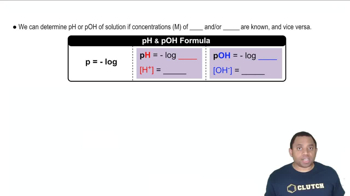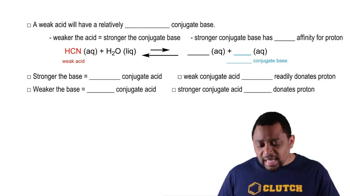Here are the essential concepts you must grasp in order to answer the question correctly.
pH and pOH
pH is a measure of the hydrogen ion concentration in a solution, indicating its acidity or basicity. It is calculated using the formula pH = -log[H+]. The pOH, which measures hydroxide ion concentration, is related to pH by the equation pH + pOH = 14. Understanding these concepts is essential for calculating the pH of solutions, especially when dealing with weak bases like NH3.
Recommended video:
Weak Base and Conjugate Acid
Ammonia (NH3) is a weak base that partially ionizes in water to form ammonium ions (NH4+) and hydroxide ions (OH-). The addition of NH4NO3 introduces NH4+, the conjugate acid of NH3, which affects the equilibrium of the ammonia solution. This relationship is crucial for understanding how the pH changes upon the addition of NH4NO3.
Recommended video:
Conjugate Acid-Base Relationships
Henderson-Hasselbalch Equation
The Henderson-Hasselbalch equation relates the pH of a buffer solution to the concentration of its acid and base components. For a weak base and its conjugate acid, the equation is pH = pKa + log([base]/[acid]). This equation is particularly useful in calculating the pH after the addition of NH4NO3, as it allows for the quantification of the ratio of NH3 to NH4+ in the solution.
Recommended video:
Henderson-Hasselbalch Equation
 Verified step by step guidance
Verified step by step guidance


